| Listing 1 - 10 of 10 |
Sort by
|
Book
ISBN: 9782729831004 2729831002 Year: 2006 Publisher: Paris Ellipses
Abstract | Keywords | Export | Availability | Bookmark
 Loading...
Loading...Choose an application
- Reference Manager
- EndNote
- RefWorks (Direct export to RefWorks)
Evolution (Biology) --- Evolution --- History --- Evolution (Biology) - History --- Evolution - History
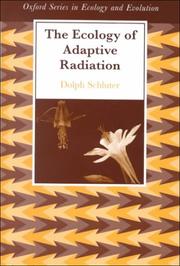
ISBN: 0198505221 019850523X Year: 2006 Publisher: Oxford Oxford university press
Abstract | Keywords | Export | Availability | Bookmark
 Loading...
Loading...Choose an application
- Reference Manager
- EndNote
- RefWorks (Direct export to RefWorks)
Adaptive radiation is the evolution of diversity within a rapidly multiplying lineage. It can cause a single ancestral species to differentiate into an impressively vast array of species inhabiting a variety of environments. Much of life's diversity has arisen during adaptive radiations. Some of the most famous recent examples include the East African cichilid fishes, the Hawaiian silverswords, and Darwin's Galapagos finches. This book evaluates the causes of adaptive radiation. It focuses on the 'ecological' theory of adaptive radiation, a body of ideas that began with Darwin and were developed through the early part of the 20th century. This theory proposes that phenotypic divergence and speciation in adaptive radiation are caused ultimately by divergent natural selection arising from differences in environment and competition between species. The text re-evaluates the ecological theory, along with its most significant extensions and challenges, in the light of all the recent evidence. It is the first full exploration of the causes of adaptive radiation in decades.
ZV Ecology --- Adaptation (Biologie) --- Adaptation (Biology). --- adaptive radiation --- diversification --- Evolution. Phylogeny --- General ecology and biosociology --- Ecology. --- Evolution (Biology). --- Adaptation (Biology) --- Ecology --- Evolution (Biology) --- Animal evolution --- Animals --- Biological evolution --- Darwinism --- Evolutionary biology --- Evolutionary science --- Origin of species --- Biology --- Evolution --- Biological fitness --- Homoplasy --- Natural selection --- Phylogeny --- Balance of nature --- Bionomics --- Ecological processes --- Ecological science --- Ecological sciences --- Environment --- Environmental biology --- Oecology --- Environmental sciences --- Population biology --- Self-organizing systems --- Variation (Biology) --- Genetics --- Ecologie --- Evolution (Biologie) --- Environmental adaptation --- Adaptation, Environmental
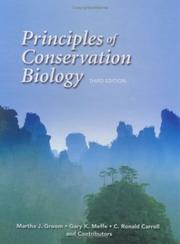
ISBN: 0878935185 9780878935185 Year: 2006 Publisher: Sunderland Sinauer Associates
Abstract | Keywords | Export | Availability | Bookmark
 Loading...
Loading...Choose an application
- Reference Manager
- EndNote
- RefWorks (Direct export to RefWorks)

ISBN: 9780813711980 0813711983 Year: 2006 Volume: 198 Publisher: Boulder Geological society of America
Abstract | Keywords | Export | Availability | Bookmark
 Loading...
Loading...Choose an application
- Reference Manager
- EndNote
- RefWorks (Direct export to RefWorks)
Geochemistry --- Atmosphere --- Evolution (Biology) --- Géochimie --- Atmosphère --- Evolution (Biologie) --- Special issues --- Géochimie --- Atmosphère --- Chemical composition of the earth --- Chemical geology --- Geological chemistry --- Geology, Chemical --- Chemistry --- Earth sciences --- Animal evolution --- Animals --- Biological evolution --- Darwinism --- Evolutionary biology --- Evolutionary science --- Origin of species --- Biology --- Evolution --- Biological fitness --- Homoplasy --- Natural selection --- Phylogeny --- Atmospheric science --- Atmosphere.


ISBN: 0913424587 9780913424582 Year: 2006 Publisher: New York American Museum of Natural History
Abstract | Keywords | Export | Availability | Bookmark
 Loading...
Loading...Choose an application
- Reference Manager
- EndNote
- RefWorks (Direct export to RefWorks)
Homology (Biology) --- Animals --- Phylogeny --- zv systematics & taxonomy --- Animal phylogeny --- Phylogenetics --- Phylogeny (Zoology) --- Animal classification --- Animal systematics --- Animal taxonomy --- Classification --- Systematic zoology --- Systematics (Zoology) --- Taxonomy, Animal --- Zoological classification --- Zoological systematics --- Zoological taxonomy --- Zoology --- POY. --- Phylogeny Reconstruction via Optimization of DNA and other Data --- Biology --- Evolution (Biology) --- Anatomy, Comparative --- Morphology --- Animals - Classification
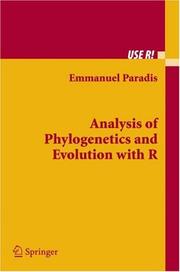
ISBN: 0387329145 9780387329147 Year: 2006 Publisher: New York Springer
Abstract | Keywords | Export | Availability | Bookmark
 Loading...
Loading...Choose an application
- Reference Manager
- EndNote
- RefWorks (Direct export to RefWorks)
Biomathematics. Biometry. Biostatistics --- Evolution. Phylogeny --- Programming --- Artificial intelligence. Robotics. Simulation. Graphics --- medische statistiek --- bio-informatica --- biostatistiek --- Europees recht --- biometrie --- KI (kunstmatige intelligentie) --- Cladistic analysis --- Phylogeny --- R (Computer program language) --- GNU-S (Computer program language) --- Domain-specific programming languages --- Animal phylogeny --- Animals --- Phylogenetics --- Phylogeny (Zoology) --- Biology --- Evolution (Biology) --- Cladism --- Cladistic method --- Cladistic taxonomy --- Cladistics --- Cladograms --- Phylogenetic systematics --- Phylogenetic taxonomy --- Taxonomy, Cladistic --- Taxonomy, Phylogenetic --- Branching processes --- Methodology --- Classification --- Bioinformatics --- Mathematical statistics --- Statistics --- Cladistic analysis. --- R (Computer program language). --- Methodology.
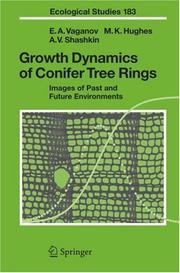
ISBN: 3642065473 3540260862 9786610607891 1280607890 3540312986 Year: 2006 Publisher: Berlin Springer
Abstract | Keywords | Export | Availability | Bookmark
 Loading...
Loading...Choose an application
- Reference Manager
- EndNote
- RefWorks (Direct export to RefWorks)
Each tree ring contains an image of the time when the ring formed, projected onto the ring's size, structure, and composition. Tree rings thus are natural archives of past environments, and contain records of past climate. While dendrochronologists have investigated the impact of climate on tree-ring growth by empirical–statistical methods, this volume presents a process-based model complementing previous approaches. Basic ideas concerning the biology of tree-ring growth and its control by environmental factors are treated, especially for conifers. The use of the model is illustrated by means of several examples from widely differing environments, and possible future directions for model development and application are discussed. The volume provides an improved mechanistic basis for the interpretation of tree rings as records of past climate. It advances process understanding of the large-scale environmental control of wood growth. As forests are the main carbon sink on land, the results are of great importance for all global change studies.
Conifers. --- Conifers-- Growth. --- Earth & Environmental Sciences --- Meteorology & Climatology --- Botany --- Fungi & Algae --- Plant Ecology --- Conifers --- Tree-rings. --- Xylem. --- Growth. --- Coniferae --- Coniferales --- Softwood trees --- Softwoods (Trees) --- Life sciences. --- Plant ecology. --- Forestry. --- Trees. --- Plant anatomy. --- Plant development. --- Climate change. --- Life Sciences. --- Plant Ecology. --- Tree Biology. --- Climate Change. --- Environmental Monitoring/Analysis. --- Plant Anatomy/Development. --- Plant cells and tissues --- Vascular system of plants --- Growth (Plants) --- Trees --- Wood --- Dendrochronology --- Gymnosperms --- Evergreens --- Figure --- Climatic changes. --- Forests and forestry. --- Monitoring/Environmental Analysis. --- Forest land --- Forest lands --- Forest planting --- Forest production --- Forest sciences --- Forestation --- Forested lands --- Forestland --- Forestlands --- Forestry --- Forestry industry --- Forestry sciences --- Land, Forest --- Lands, Forest --- Silviculture --- Sylviculture --- Woodlands --- Woods (Forests) --- Agriculture --- Natural resources --- Afforestation --- Arboriculture --- Logging --- Timber --- Tree crops --- Plant structure --- Plants --- Structural botany --- Vegetable anatomy --- Anatomy --- Changes, Climatic --- Changes in climate --- Climate change --- Climate change science --- Climate changes --- Climate variations --- Climatic change --- Climatic changes --- Climatic fluctuations --- Climatic variations --- Global climate changes --- Global climatic changes --- Climatology --- Climate change mitigation --- Teleconnections (Climatology) --- Dendrology --- Nursery stock --- Woody plants --- Forests and forestry --- Ecology --- Structure --- Environmental aspects --- Environmental Sciences and Forestry. Forestry -- Forest Trees --- ALLW. --- Phytoecology --- Vegetation ecology --- Environmental monitoring. --- Development of plants --- Plant development --- Developmental biology --- Biomonitoring (Ecology) --- Ecological monitoring --- Environmental quality --- Monitoring, Environmental --- Applied ecology --- Environmental engineering --- Pollution --- Ontogeny --- Measurement --- Monitoring --- Floristic ecology --- Global environmental change --- Environment. --- Environmental Sciences. --- Environmental Monitoring. --- Plant Development. --- Development. --- Balance of nature --- Biology --- Bionomics --- Ecological processes --- Ecological science --- Ecological sciences --- Environment --- Environmental biology --- Oecology --- Environmental sciences --- Population biology
Book
ISBN: 3935751036 9783935751032 Year: 2006 Volume: *2 Publisher: Tübingen Kerns Verlag
Abstract | Keywords | Export | Availability | Bookmark
 Loading...
Loading...Choose an application
- Reference Manager
- EndNote
- RefWorks (Direct export to RefWorks)
Neanderthal race --- Prehistoric peoples --- Archaeology --- Ethnography --- Homme de Néanderthal --- Homme préhistorique --- Archéologie --- Neanderthals. --- Ethnology --- Homme de Néanderthal --- Homme préhistorique --- Archéologie --- Human evolution --- Neanderthals --- Evolution (Biology) --- Physical anthropology --- Evolutionary psychology --- Human beings --- Homo mousteriensis --- Homo neanderthalensis --- Homo primogenicus --- Homo sapiens neanderthalensis --- Neandertalers --- Neandertals --- Neanderthalers --- Fossil hominids --- Origin
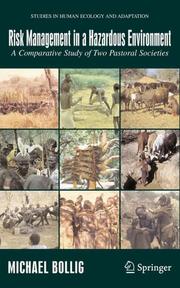
ISBN: 9780387275826 0387275819 9780387275819 1441939024 9786612823718 0387275827 128282371X Year: 2006 Publisher: New York, NY : Springer US : Imprint: Springer,
Abstract | Keywords | Export | Availability | Bookmark
 Loading...
Loading...Choose an application
- Reference Manager
- EndNote
- RefWorks (Direct export to RefWorks)
A research focus on hazards, risk perception and risk minimizing strategies is relatively new in the social and environmental sciences. This volume by a prominent scholar of East African societies is a powerful example of this growing interest. Earlier theory and research tended to describe social and economic systems in some form of equilibrium. However recent thinking in human ecology, evolutionary biology, not to mention in economic and political theory has come to assign to "risk" a prominent role in predictive modeling of behavior. It turns out that risk minimalization is central to the understanding of individual strategies and numerous social institutions. It is not simply a peripheral and transient moment in a group’s history. Anthropologists interested in forager societies have emphasized risk management strategies as a major force shaping hunting and gathering routines and structuring institutions of food sharing and territorial behavior. This book builds on some of these developments but through the analysis of quite complex pastoral and farming peoples and in populations with substantial known histories. The method of analysis depends heavily on the controlled comparisons of different populations sharing some cultural characteristics but differing in exposure to certain risks or hazards. The central questions guiding this approach are: 1) How are hazards generated through environmental variation and degradation, through increasing internal stratification, violent conflicts and marginalization? 2) How do these hazards result in damages to single households or to individual actors and how do these costs vary within one society? 3) How are hazards perceived by the people affected? 4) How do actors of different wealth, social status, age and gender try to minimize risks by delimiting the effect of damages during an on-going crisis and what kind of institutionalized measures do they design to insure themselves against hazards, preventing their occurrence or limiting their effects? 5) How is risk minimization affected by cultural innovation and how can the importance of the quest for enhanced security as a driving force of cultural evolution be estimated?
Social Sciences. --- Anthropology. --- Community & Population Ecology. --- Social sciences. --- Ecology. --- Sciences sociales --- Ecologie --- Anthropologie --- Africa -- Environmental conditions. --- Environmental risk assessment -- Africa. --- Himba (African people) -- Social conditions. --- Human ecology -- Africa. --- Indigenous peoples -- Ecology -- Africa. --- Risk management -- Africa. --- Suk (African people) -- Social conditions. --- Human ecology --- Environmental risk assessment --- Risk management --- Indigenous peoples --- Suk (African people) --- Himba (African people) --- Anthropology --- Sociology & Social History --- Social Sciences --- Social Change --- Anthropogeography & Human Ecology --- Ecology --- Social conditions --- Social conditions. --- Africa --- Environmental conditions. --- Cimba (African people) --- Himba (Bantu people) --- Luzimba (African people) --- Ovahimba (African people) --- Ovazemba (African people) --- Ovazimba (African people) --- Shimba (African people) --- Simba (African people) --- Tjimba (African people) --- Vatwa (African people) --- Zemba (African people) --- Bawgott (African people) --- Hill Suk (African people) --- Pakot (African people) --- Plains Suk (African people) --- Pokot (African people) --- Suks --- Aboriginal peoples --- Aborigines --- Indigenous populations --- Native peoples --- Native races --- Community ecology, Biotic. --- Ethnology --- Nilotic peoples --- Insurance --- Management --- Bantu-speaking peoples --- Risk assessment --- Precautionary principle --- Eastern Hemisphere --- Human beings --- Biocenoses --- Biocoenoses --- Biogeoecology --- Biological communities --- Biomes --- Biotic community ecology --- Communities, Biotic --- Community ecology, Biotic --- Ecological communities --- Ecosystems --- Natural communities --- Population biology --- Behavioral sciences --- Human sciences --- Sciences, Social --- Social science --- Social studies --- Civilization --- Adivasis --- Balance of nature --- Biology --- Bionomics --- Ecological processes --- Ecological science --- Ecological sciences --- Environment --- Environmental biology --- Oecology --- Environmental sciences --- Primitive societies --- Social sciences
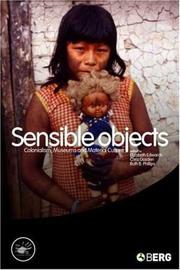
ISBN: 9781845203245 9781845203238 1845203240 1845203232 9781003086611 1003086616 9781000183436 1000183432 9781847883155 9781000186949 1000186946 9781000190069 1000190064 1474215467 184788315X 9781474215466 Year: 2006 Publisher: Oxford New York Berg
Abstract | Keywords | Export | Availability | Bookmark
 Loading...
Loading...Choose an application
- Reference Manager
- EndNote
- RefWorks (Direct export to RefWorks)
Anthropologists of the senses have long argued that cultures differ in their sensory registers. This groundbreaking volume applies this idea to material culture and the social practices that endow objects with meanings in both colonial and postcolonial relationships. It challenges the privileged position of the sense of vision in the analysis of material culture. Contributors argue that vision can only be understood in relation to the other senses. In this they present another challenge to the assumed western five-sense model, and show how our understanding of material culture in both historical and contemporary contexts might be reconfigured if we consider the role of smell, taste, touch and sound, as well as sight, in making meanings about objects.
Ethnology. Cultural anthropology --- geschiedenis --- history [discipline] --- cultureel erfgoed --- museology --- cultural heritage --- museumkunde --- History of civilization --- Museology --- Anthropology. --- Material culture. --- Senses and sensation. --- Anthropologie --- Culture matérielle --- Sens et sensations --- Postcolonialisme --- Colonies --- Musées ethnographiques --- Body, Human --- Colonies. --- Ethnological museums and collections. --- Human body --- Postcolonialism. --- Social aspects. --- Culture matérielle --- Ethnological museums and collections --- Material culture --- Postcolonialism --- Senses and sensation --- Sensation --- Sensory biology --- Sensory systems --- Knowledge, Theory of --- Neurophysiology --- Psychophysiology --- Perception --- Post-colonialism --- Postcolonial theory --- Political science --- Decolonization --- Culture --- Folklore --- Technology --- Ethnological collections --- Ethnology --- Anthropological museums and collections --- Anti-colonialism --- Colonial affairs --- Colonialism --- Neocolonialism --- Imperialism --- Non-self-governing territories --- Colonization --- Social aspects --- Museums --- Postcolonialisme. --- MAD-faculty 17 --- opleiding art sense(s) lab --- cultuurgeschiedenis --- cultuursociologie --- geurkunst --- Culture matérielle. --- Musées ethnographiques.
| Listing 1 - 10 of 10 |
Sort by
|

 Search
Search Feedback
Feedback About
About Help
Help News
News